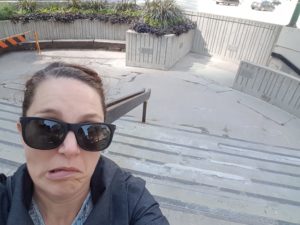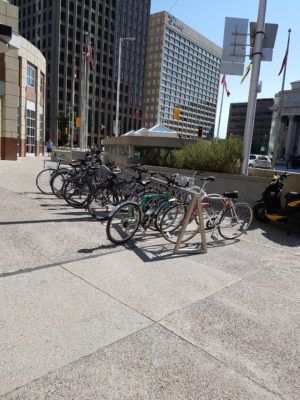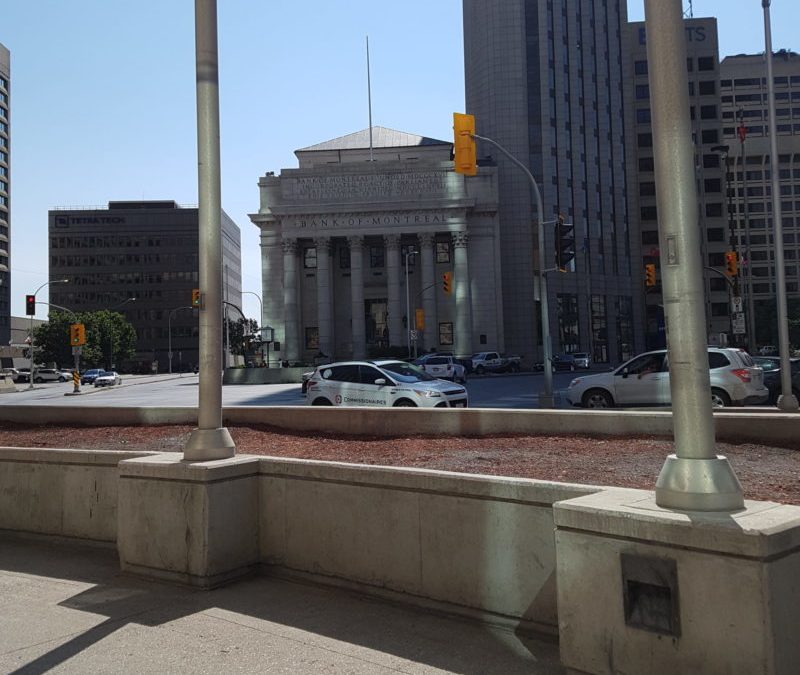Every city has that intersection. When in London, you go to Trafalgar Square. Visiting Toronto, Young and Dundas. NYC has famous Times Square. When listing of the most famous intersections in Canada, we have Portage and Main right here in Winnipeg, described as “the heart of the continent.”
Don’t miss Part 2 of this series, Portage+Main: Beyond The Intersection
Change is afoot at Portage and Main, with the 40 year lease requiring barricades at the intersection expiring. Back in ‘79, the hope was this development would be a mega-project in the right direction, bringing more people to downtown since we’d now created a driver’s dream. Cars only, no people, VROOM VROOM!

Money will be spent on Portage and Main regardless. The current infrastructure is … gross.
Of course, we’ve learned a lot since 1979, and unfortunately in this case, we had to learn the hard way. Instead of driving investment, closing the intersection to people has created a vortex in the heart of downtown. Since the barricades went up, The Forks has been revitalized, the Exchange District (east and west) is booming and Downtown is seeing new life and business in the SHED district, along Broadway and through investment from the University of Winnipeg.
But, at Portage and Main, we see surface parking lots and a pedestrian crossing so complicated, most people avoid it altogether. Those who are mobility challenged have to use a series of lifts, making their crossing time 9 minutes or more, or they must travel 400 meters to cross somewhere else, due to lack of open elevators after business hours.
For those of you who experience Portage and Main in your car, I took a trip around the intersection and shared some photos of my experience in a Twitter story here!
This October, the citizens of Winnipeg will get to vote on what they think should happen at this famous intersection. With the expired lease and the barricades crumbling, we have the chance to voice our support in favour of the status quo (spend the money to rebuild the barricades) or to re-imagine the intersection as open, accessible and vibrant.
This is a divisive issue in our city these days! Here at Green Action Centre, many of our staff are passionately supporting the opening, and wanted to address the chief arguments against the opening. We hope you can assist in sharing these facts with your neighbours, friends and family.
OPENING THE INTERSECTION WILL CREATE A TRAFFIC NIGHTMARE
False. Traffic studies have been done, most recently by Dillon consulting. For a clear summary, check out Brent Bellamy’s Shedding Light On Portage and Main in the Winnipeg Free Press. Most traffic moves north-south through the intersection, and no delay was found for those drivers. On average, traffic during morning rush hour would experience a 30 second delay, afternoon rush hour a 50 second delay.
For pedestrians, those who are able bodied have to walk about 400 meters out of their way to cross, as not all of the blocks connect across (for example, Lombard isn’t an alternate route for those on the northwest corner looking to go to the northeast. On the south side, you have to navigate the crossing at Pioneer, which is not very pedestrian friendly to put things mildly.) I timed getting from 201 Portage to the BMO building from both directions. From 201 going east, it took me 12 minutes, and then from the BMO Building to 201 going west, it took me 8 minutes. I’m an able bodied, athletic 35 year old, but I tried walking at an average pace as opposed to my usual hustle. To navigate underground, it took an average of 4-6 minutes to do the crossing.
For a Green Action event, we had to cross Portage and Main with a wagon this past June to bring materials for the Commuter Challenge wrap up lunch to the Fairmont Hotel. To cross using the elevators, as someone in a wheelchair would, it took us 15 minutes. To cross the street. Fifteen minutes.
During the 10 hours a week of rush hour, a majority of cars will experience no delays, while others will experience an average of 30 seconds (AM) to 50 seconds (PM). The highest possible delay is 8 minutes. And the Dillon report did not consider re-syncing the lights or other solutions to even this minor delay.
Currently, those on foot take 4 to 6 minutes to cross underground, or 8 to 12 minutes to cross over ground, or 9-15 minutes to cross if they have accessibility issues (provided all the lifts are open, which many aren’t evenings and weekends).
It’s important to note that Portage and Main is not Winnipeg’s busiest traffic intersection. It’s also important to question why we build roads, which are public spaces for all people, to accommodate cars 10 hours a week, but we don’t consider how effective the road is at accommodating all people 24 hours a day, 7 days a week. We need to build complete streets to function appropriately for all.
SOMEONE WILL BE KILLED

If we really closed Portage and Main “for safety”, why is this adjacent intersection with two major bus stops so incredibly uninviting and unsafe for those on foot?
This is an alarmist argument. Portage and Main doesn’t have the highest traffic volumes in the city, and it is no larger than the crossing just to the south at Broadway and Main.
It’s important to remember that the intersection is not simply going to have the barriers removed and then a free for all. A redesign of the intersection will ensure the smooth flow of buses, pedestrians, bikes and cars.
Perhaps the solution to no pedestrian deaths should be no personal vehicles in the downtown, since they are too dangerous through a busy urban centre.
Hmmmmm ….
WHAT A WASTE OF MONEY
With every project, we can always look at it and say “that money would be better spent somewhere else!” Be it to build the Waverley Underpass, Plessis Underpass, that upcoming Kenaston project that’ll cost 450 million, or simply refurbishing and maintaining local splash pads and parks, we all have an opinion on what we want tax dollars spent on.
In the case of Portage and Main, the budget proposed is 6 million, which is a fraction of the cost of most road projects ($155 million for the Waverley Underpass, and $450 million is the budget for a 2 km stretch of Kenaston).
At Portage and Main, money is going to be spent regardless of the plebiscite. There is no option to just “leave it as it is” as the infrastructure is crumbling (exposed rebar, mold, leakage, it’s a mess). Now is the time to decide: do we spend the cash on opening the intersection, which will benefit business and support a more accessible, walkable, vibrant city, or do we spend the money to rebuild the barricades once again?
At Green Action Centre, we want you to think about the future

Instead of a vibrancy, the blocks around Portage and Main are primarily half empty surface parking lots that are poorly maintained. Imagine actual businesses here.
We encourage readers to get informed about the intersection. How have the barricades impacted the past 40 years of development and how could the next 40 years be different? Check out the Downtown Winnipeg BIZ’s event, Imagine Portage and Main, from 2016.
People are changing, and so is Winnipeg. CAA Manitoba and Bike Winnipeg just released survey results showing that bike commuting is on the rise, with opportunities for a surge as safe infrastructure is built. We also need to keep in mind that young Canadians are driving less and putting higher value in transit friendly lifestyles and in walkable neighbourhoods.
And walkability drives commerce. In 1979 it was thought that making downtown friendly to drivers was the key to success, but in 2018 we have the data showing more people on foot and bike is good for business. If you want more examples on how infrastructure for people drives up business,

All around the intersection were full bike racks. People riding for their everyday commutes is on the rise. Are we building for this change in behaviour?
and you missed Janette Sadik-Khan when she was in Winnipeg this spring, check out her Ted Talk here.
Most importantly, we want our city to be accessible for all ages and abilities to travel safely and with dignity. Anyone arguing that pedestrians should “just go around” the intersection had best rent a wheelchair or crutches and experience the crossing for themselves.
If you want to support the effort to open Portage and Main, join Team Open. This is a volunteer effort and your voice and talents would be welcome!
It is never easy to change, and we understand that those who primarily drive might have a hard time seeing the benefit of opening the intersection. We hope those who don’t live, work and play downtown, can listen to the businesses, the traffic engineers and the research to ensure Winnipeg continues to develop into a livable city for our growing population.




Thanks for the article!
My stepson and I are at odds with this one. He’s pro-opening and I was/am leaning against opening.
One reason is that 90 more seconds (minimum) of cars idling each day at the lights can’t be good for the environment.
Secondly as someone who remembers crossing there as a kid, it was extremely scary!! I have used the underground walkway numerous times. Much safer, calmer, and weather friendly. I guess it’s in the plebiscite’s hands. ????
Thanks for reading, Bonnie! Winnipeg does indeed have to tackle the number of people who drive alone as their regular commute, as that number is 72%. This is extremely high, especially as we move to being a city of one million. I wanted to highlight the “thinking about the future” of Winnipeg at the bottom of the blog, as we have an incredible opportunity to move people away from choosing to drive alone as their regular commutes by focusing our infra spending on projects that create bike, transit and walking friendly infrastructure, as well as tools like GoManitoba that assist people in finding carpool partners. By focusing our attention on advocating for solutions to our drive-alone problems, we can have a far bigger impact than simply keeping one intersection barricaded. It’s important to note that the opening of the intersection won’t be simply removing the barricades and returning the intersection to the layout in 1979. Much has been learned from major intersections around the world on how to move transit, bikes, pedestrians and cars through intersections smoothly. The opening of Portage and Main is a chance for a redesign of the flow through the intersection, as cities are becoming much better at asking the question: “how do we move more people through this intersection” as opposed to the old “how do we move more cars through this intersection”.
I hope you’ll keep thinking about this project and that you might be swayed over to the Vote Open side!
Great overview Mel. I hope most Winnipegers will come to see the many good reasons for opening up Portage and Main, and this post is a great contribution to that. Above all, opening the intersection will have a positive impact on the walkability of downtown, perception and reality of security at that corner, and be an important piece in the repair of downtown’s fragmented urban fabric. A walkable downtown is a green downtown.